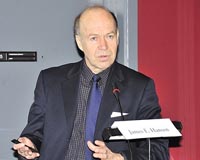| . |  |
. |
Copenhagen (AFP) Dec 10, 2009 Just five years ago, anyone who talked of easing Earth's climate crisis by fertilising the seas with iron, scattering particles in the stratosphere to reflect sunlight or building a sunshade in space courted ridicule. Today, such advocates -- "geo-engineers" -- are getting a respectable hearing. Their ideas are still beyond the scientific pale, for they remain contested as risky for the environment and laden with unknowns about cost, practicality and legality. But mainstream scientists who once dismissed these projects are now looking at them closely. And some grudgingly accept that at least some concepts are worth exploring as a possible "Plan B" -- a last-resort option if political efforts to tackle global warming fail and catastrophe looms. Plan A hangs in the balance at the December 7-18 UN talks in Copenhagen, where 194 nations are called to craft a post-2012 treaty to slash greenhouse-gas emissions. But the negotiations are hideously complex, a Gordian knot of interlinked issues, national interests and economic stakes. The plodding, consensus-driven process is being far outstripped by the surge of fossil-fuel emissions, placing Earth on course for as much as 3.5 degrees Celsius (6.3 degrees Fahrenheit) of warming over pre-industrial times, way over a 2.0 C (3.6 F) threshold widely considered safe. "A lot of people don't like to say that Plan A is not working," Jip Lenstra, a senior scientist at the Energy Research Centre of the Netherlands, told AFP at the Copenhagen talks. "They know that, but they don't want to say that aloud because it's very frustrating and it's not the right signal at the right time. "If you are working quite hard to make a success of Plan A, and somebody says that we should look at Plan B if Plan A is not successful, that's not a good strategy." Geo-engineering broke new ground this year with an assessment of its options by Britain's Royal Society, one of the temples of science. A 12-member panel found that some geo-engineering techniques could have "serious unintended and detrimental effects on many people and ecosystems." But they cautiously said some schemes were technically feasible and could be a useful fallback tool to help the switch to a low-carbon economy provided safety worries and doubts about affordability were answered. The UN's Intergovernmental Panel on Climate Change (IPCC) inveighed against geo-engineering schemes in its landmark Fourth Assessment Report in 2007, swiping them in a brief aside as charged with potential risk and unquantified cost. It now intends to do its own evaluation of the mavericks. The Royal Society said geo-engineering fell into two main categories. The most promising entails removal of carbon dioxide, such as by planting forests and building towers that would capture CO2 from the air. Some of these projects could be harnessed alongside conventional methods to reduce emissions once they are demonstrated to be "safe, effective, sustainable and affordable," said the report. The other category is called solar radiation management. Instead of tackling CO2, it would act like a thermostat, turning down the heat that reaches Earth from the Sun. Concepts in this field include deflecting the Sun's heat away from the Earth through space mirrors, scattering light-coloured particles in the high atmosphere to reflect the solar rays and using ships to spray water that would create reflective low-altitude clouds. The advantage would be to lower temperatures quickly and could be tempting if global warming suddenly cranked up a gear, the report said. But these techniques would not curb CO2 emissions that cause dangerous ocean acidification; their costs are unclear but possibly astronomical; and they may end up generating disasters of their own. Even so, they should not be dismissed out of hand, given their potential in an emergency, says Ken Caldeira, a professor of climate modelling at Stanford University, California, who took part in the Royal Society report. "We need to think if Greenland were to be sliding into the sea rapidly, causing rapid sea-level rise, or if methane started to de-gas rapidly from the Siberian permafrost, or if rainfall patterns were to shift in such a way that wide-spread famines were induced," he said in London in September. "We would be remiss if we did not do what we could do to understand the potential of these options as well as their uncertainties and risks ahead of time." Share This Article With Planet Earth
Related Links Climate Science News - Modeling, Mitigation Adaptation
 Top climate scientist wants Cop15 to fail
Top climate scientist wants Cop15 to failCopenhagen, Denmark (UPI) Dec 9, 2009 A top climate scientist said the negotiations in Copenhagen are so flawed that he wants them to fail. "The whole approach is so fundamentally wrong that it is better to reassess the situation," James Hansen, one of the world's most respected climate scientists, told British daily The Guardian. "If it is going to be the Kyoto-type thing then (people) will spend years trying to determine ... read more |
|
| The content herein, unless otherwise known to be public domain, are Copyright 1995-2009 - SpaceDaily. AFP and UPI Wire Stories are copyright Agence France-Presse and United Press International. ESA Portal Reports are copyright European Space Agency. All NASA sourced material is public domain. Additional copyrights may apply in whole or part to other bona fide parties. Advertising does not imply endorsement,agreement or approval of any opinions, statements or information provided by SpaceDaily on any Web page published or hosted by SpaceDaily. Privacy Statement |